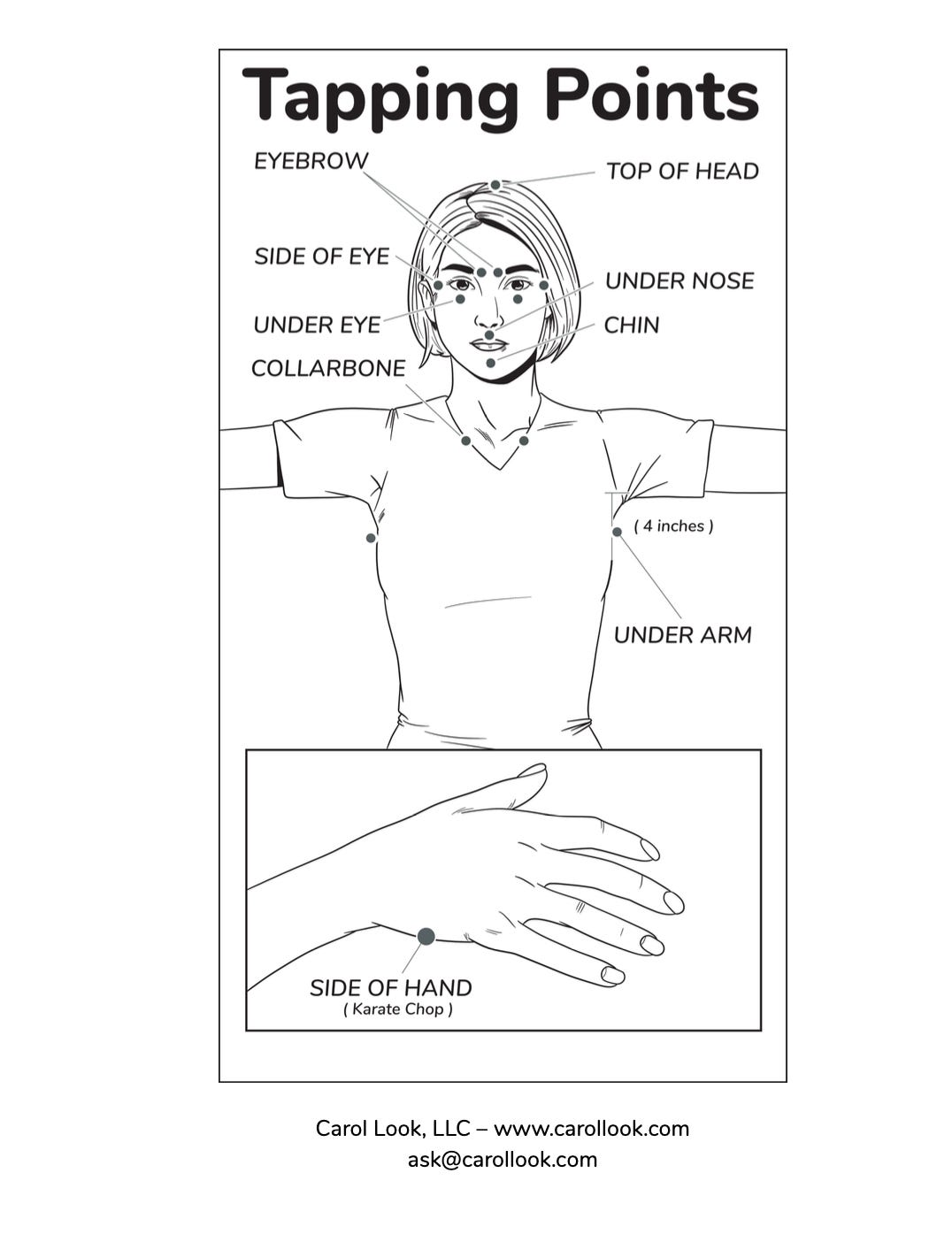“Once you find the purpose of your self-sabotaging behavior— the point of protection—you can get to work dismantling it and becoming more successful, productive, and fulfilled in your everyday life.” — Carol Look, The Yes Code : Transforming Sabotage Into Success, p. 68).
In recent weeks, I had the pleasure of reading The Yes Code : Transforming Sabotage Into Success by Carol Look. Carol is an author in the same Thought Leader Academy program that I am participating in this year and I was glad to purchase her book in order to learn more about the modality of emotional freedom technique (EFT) AKA Tapping. I encourage you to buy the book here.
EFT is a mindfulness modality that I have seen grow in popularity online in recent years. I first learned about it on instagram a few years ago and soon after seeing it, I began practicing it myself. However, I picked up the book because I figured there was more to know about the actual origins of this therapeutic practice and the official technique. Individuals on instagram can sort of skew the modality to create something of their own with it— basically mixing EFT movements with affirmations, but there is an official technique for EFT, which I learned from reading this book.

I finished reading the book this week and I also spoke with a friend of mine, an older lady, who had actually come to something similar to EFT herself. She was not aware of it as a therapeutic treatment until I mentioned it, but she had come to tapping on parts of her face to release stress in a similar manner, just by naturally following her body’s wisdom. There is wisdom in the body and there are likely many ways that practices similar to EFT are helpful. I am grateful that we have emotional technologies such as these becoming more popular and colloquial in our culture. Regardless of how you come to know it, any mindfulness practice or therapeutic treatment like this has tremendous healing power.
In this post, I am providing a report on the book by following the table of contents and sharing my favorite quotes from each section to demonstrate my primary takeaways about EFT.
The Yes Code : Transforming Sabotage Into Success by Carol Look
Introduction
The book opens with one of the most impactful quotes of the last century, although its authorship is unknown: “Between stimulus and response there is a space. In that space is our power to choose our response. In our response lies our growth and our freedom.” —Unknown author (often misattributed to Viktor Frankl). [Note: This quote represents a summation of Frankl's philosophy but does not appear in his published works. Origin uncertain, popularized by Stephen R. Covey.]
In her book, Carol defines self-sabotaging behavior using the Cambridge dictionary: “Self-sabotaging behavior refers to intentional action (or inaction) that undermines people’s progress and prevents them from accomplishing their goals. Self-sabotage occurs when people hinder their own success.” (p. 9).
“How you feel and what you believe govern your behavior.” (p. 10).
“The reason self-sabotaging behavior is so common is because above all other priorities, human beings need to feel safe. And if being visible, shining or being successful makes you feel unsafe, you won’t take the necessary steps to achieve your goals. Your might try to convince yourself and others that you want to reach your goals, but your need for emotional safety will win every time.” (p. 10)
“Remember, a trauma can be any incident that makes you feel terrified or helpless.” (p. 11)
“Preserving your emotional safety comes before almost anything else you might need in your life.”
“Remember, while your self-sabotaging behavior is creating a block for you, it is also solving a problem. Identify what problem your self-sabotaging behavior is solving for you and then you can use the most efficient tools available to heal and release these blocks. The self-sabotaging behavior then becomes unnecessary. In fact, it stops on its own.” (p. 17).
“The brain and nervous system don’t differentiate between a real threat and a threat we imagine in our minds.” (p. 18).
Carol Look’s three-step process of The Yes Code (p. 21):
Clarify your desired vision for your life…by asking the right questions
Heal and release the fears and beliefs that were uncovered by the questions in step one.
Reevaluate your choices, come from a place of alignment and gratitude, and take inspired actions. You will start to move forward with ease and grace as you find your next yes. (My emphasis).
What is EFT?
“Research studies from Dr. Peta Stapleton, the leading EFT researcher using Clinical EFT, have highlighted phenomenal changes from using EFT including a 40% decrease in anxiety, a 37% reduction in cortisol (the stress hormone), a 74% reduction in food cravings, and a 32% reduction in PTSD symptoms. After the treatment protocols were follows, the study showed a 31% increase in reported happiness, and a 113% improvement in immune system markers.” (p. 22).
“Practitioners tell newcomers it’s like psychological acupuncture that will rewire your brain.” (p. 23).
Part One: The Beginning
“I was told I was ‘too sensitive’ which, while true, didn’t help me combat the anxiety…Rather than being a curse, being too sensitive turned out to be a gift I learned to appreciate over time. It was a gift wrapped in crappy wrapping paper and caused me a lot of emotional pain before I knew what it was, but I wouldn’t give it up for anything. It has helped me enormously in my work and my relationships.” (p. 34).
“Yes, my family was riddled with substance abuse, but what I didn’t know at the time was that the real problem was untreated worry, hurt, and anxiety.” (p. 34, my emphasis).
“Numerous trauma experts and researchers agree that the primary emotional features for an event to be categorized as traumatic are feeling unsafe and feeling helpless.” (p. 38).
What is EFT?
“EFT is a form of emotional technology, and its mechanism of healing—tapping on acupuncture points while tuning into emotional challenges—calms down the fight or flight mechanism in the brain which in turn create psychological space for people to process old emotional pain and be less reactive.” (p. 52).
The Hope
“When you treat the underlying problem— your fears, terror, traumas, and your feeling of guilt, grief, and helplessness— you don’t need to people please, become addicted, or hide under the radar so someone’s jealousy won’t hurt you.” (p. 61).
Part Two: The Problem
In this section of the book, Carol defines and unpacks the seven most common self-sabotaging behaviors and presents EFT tapping sequences for healing.
“Being stuck is evidence that your fear is stronger than your desire. That’s when you start interfering with your own success.” (p. 65).
The top seven self-sabotaging behaviors:
Procrastination
Perfectionism
People Pleasing
Addictions
Clutter
Relationship Drama
Self-care Neglect
“What you need to uncover is what your self-sabotaging behavior is trying to tell you— scream at you in some cases—and then you can go about releasing this pattern…” (p. 67).
“It’s all about protection, and as a human being, what your nervous system perceives as emotional safety always come first. The outside behaviors are being used to protect your insides. Once you find the purpose of your self-sabotaging behavior— the point of protection—you can get to work dismantling it and becoming more successful, productive, and fulfilled in your everyday life.” (p. 68, my emphasis.)
The Key to Getting Better Results
“All the results that show up in our lives are driven by our emotions, our beliefs and our behaviors. Therefore, if we want to get better results, we’ll need to address one of these three areas. Our options are to:
Release our fears
Replace our limiting beliefs
Stop our self-sabotaging behaviors” (p. 75).
The Root Cause of Self-Sabotaging Behavior
“When a client comes seeks help from me with a desire to change a behavior or habit, I always ask the following two questions:
What is the upside of your self-sabotaging behavior?
What is the downside of letting it go and reaching your goal?
At first, clients balk and these questions and tell me there is no possible upside to doing something that slows them down. In time, and with more refine questions, all my clients have been able to up with a reason (their real why) that they keep getting in their own way.” (p. 82).
Part Three: The Solution
“Helpful questions to ask when you’re starting to clarify your vision are:
What result do I want in my life?
What will my success look like when I get here?
How will I know when I’ve arrived?
What will realizing my vision of success give me in my life?” (p. 109).
All about EFT (“Tapping)
“The original method of tapping on acupuncture points was called Thought Field Therapy, and was created by a psychology on California, Dr. Roger Callahan. Dr. Callahan found that by connection to a client’s acupuncture points through tapping with your fingertips the brain would quiet down the fight or flight response… the usual anxious response would go away. Then Gary Craig, a Stanford trained engineer and personal performance coach in California, simplified the complex ‘algorithms’ of Dr. Callahan’s original tapping prescriptions, and names his version of the tapping procedure, Emotional Freedom Techniques, of EFT. Most tapping practitioners have been using this simplified version of tapping since the 1990s.” (p. 119).
Graphic of tapping points (p. 121)
How to Use EFT Effectively
“Once you learns the exact steps of EFT, the process is quite simple. When you follow the steps, you’ll get results.
Choose your target. (my note: meaning emotional target)
Measure your fear or distress on the 0-10 point scale (10 is the highest level of stress or discomfort and 0 represents no stress of feeling neutral about the target
Create a setup statement (my note: The formula is “Even though I (state target feeling), I totally and completely love and accept myself.”)
Tap on the acupoints while repeating the target you have chosen
Re-test on the 0-10 point scale
Repeat tapping rounds
“The set up statement includes a description of the fear, belief, or memory and a phrase of acceptance.” (p. 125).
For the remainder of the book, Carol Look provides guidance and tapping sequences to heal patterns of those 7 most common self-sabotaging techniques. I think this book was great and this technique is healing and lovely. I have been practicing EFT more consistently since I began reading the book in May— two to three rounds morning and night, and I love the benefits of it.
Some questions for you, reader:
Do you have experience with EFT or are you interested in trying it now?
Did you like this book report?
I hope this gave you some valuable insight into EFT and the benefits that it can provide including more ease and more grace and more success— all things we love so much over here! 💗
Happy Juneteenth! I am happy to be back home with my husband and my kittens. Whether you're celebrating the holiday or having a regular workday, I hope it's a beautiful one.
xoxo,
Sophia
P.S. My next post will explore the spiritual significance of osprey encounters, inspired by my recent visit to North Florida. Paid subscribers will receive the full post, while free subscribers can access the preview. The full post will include personal reflections and practical guidance that will really resonate with anyone seeking deeper meaning in nature's messages. 🩵





